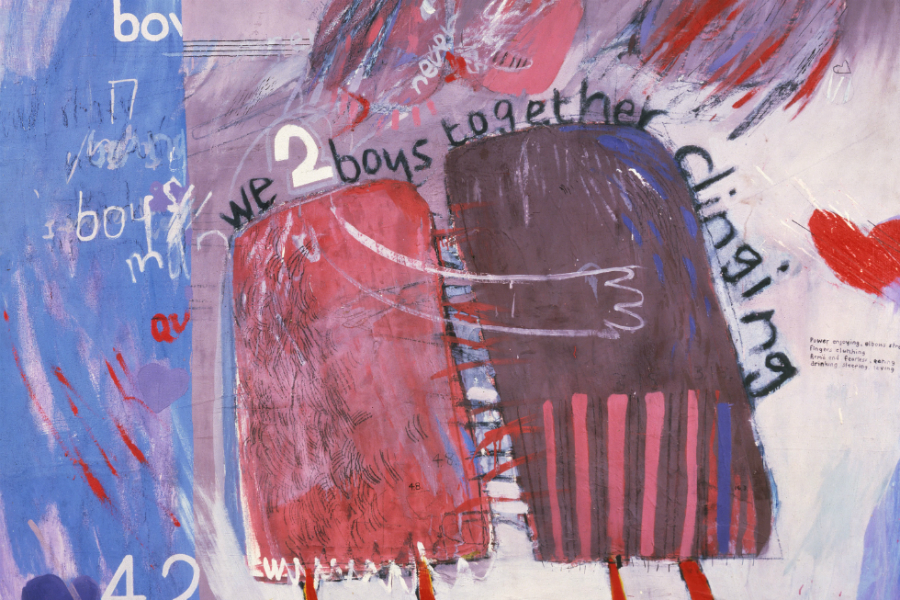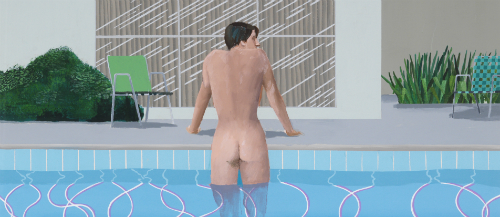Painting Pioneer: Early Reflections of David Hockney

A gay art student struggling with his identity in ’60s London? Steph Moffat views a young Hockney before the fame…
David Hockney, commonly regarded as one of our greatest living artists, is best known for his erotic paintings of male nudes lounging in bed or emerging from sun-drenched Californian pools, and most recently, his huge, delightfully bold depictions of the Yorkshire countryside. His show at the Royal Academy, A Bigger Picture, was the fifth most visited exhibition in the world last year, pulling in crowds of 650,000 people.
It’s easy to forget that this 76 year old art-veteran was once a young student, struggling with his identity both as an artist and as a gay man living in London in the 1960s.
The Walker Gallery’s current exhibition, Early Reflections, proves a concise reminder of this. It is, as the name suggests, a collection of Hockney’s earlier works (made from 1960 to 1978), the oldest of which was made during his time at the Royal College of Art in London.
It was at the college that he met Ron Kitaj — a fellow student who would later become a well-known pop artist — who advised Hockney to create work based on his own interests, rather than those of his tutors. He also met Adrian Berg, an openly gay painter who shared a studio with Kitaj, and introduced him to the poetry of Walt Whitman and Constantine Carafy.
The influence of these two men is clear in Hockney’s paintings, particularly as he begins to incorporate text. We Two Boys Together Clinging (1961) takes its name from a Whitman poem, and portrays a couple in a bright, expressive scrawl against a dull grey background. It also references a newspaper headline at the time, Two Boys Cling to Cliff All Night, which hints at Hockney’s crush on the singer Cliff Richard.
The text grows steadily bolder in the surrounding works. Simple and direct words like ‘Queen’ and ‘Queer’ splatter his paintings in far less subtle ways of citing his sexuality. This writing, reminiscent of graffiti in public toilets, gives a human element to his paintings; it’s a reminder that they were made by an artist with his own opinions and desires. In a time when homosexuality remained illegal, these paintings are unapologetic declarations of defiance.

By now Hockney is gaining conviction in his pursuit of beauty. When asked to produce a series of life drawings around this period, he refused to paint the ‘old fat woman’ who regularly modelled, claiming that an artist should find his sitter attractive. Instead, he used figures from American physique magazine and his friend Mo McDermot as his subjects.
Despite his growth in confidence, Hockney remains charmingly humble; he was, in many ways, still unsure of himself and often doubted his abilities. Nestled amongst the frames in the Walker we find this quote: ”I never thought my painting advanced, but in 1964 I still consciously wanted to be involved, if only peripherally, with modernism.” It seems absurd to think now that like many current art students, Hockney was questioning his place in the art industry and searching for somewhere to belong.
After moving to Los Angeles in 1964, his work appears to be less about an underground subculture and more about a glamorous and exotic lifestyle. He appears liberated by his surroundings and his new bohemian friends and produces a wealth of paintings, prints, and drawings that celebrate male beauty.
Peter Getting Out of Nick’s Pool (1966) is one of Hockney’s most famous pieces, winning the John Moores Painting Prize in 1967. It is a vibrant work that combines Hockney’s obsessions with water, light and the figure. It couldn’t be more different to the grungy and almost childlike qualities of his paintings during art school. He appears to have found his place.
In recent years, Hockney has moved away from portraiture and is now focusing his attention on the landscapes surrounding his home in Bridlington, Yorkshire. Many people view this change in a negative way; has Hockney, once a daring artist tackling the taboo, lost his touch and begun to play it safe?
Homosexuality is now a common theme in western popular culture; almost every TV show has a gay character and the UK’s first same sex marriages are due to take place in March 2014. It is no longer shocking to be homosexual. Yet landscape paintings are far from being in vogue. They’re dismissed as old fashioned and decorative, but here Hockney is, continuing to paint subjects that are, at first glance, neglected and uncool. Look again and the painter is utilising the most current technology; iPad and iPhone paintings were unveiled alongside watercolour, charcoal and video works in San Francisco this year.
Hockney may have found beauty in topics and mediums closer to home, but he continues to be a painting pioneer, albeit in more subtle yet nevertheless compelling ways.
Steph Moffat
Galleries open 10-5pm, free entry





